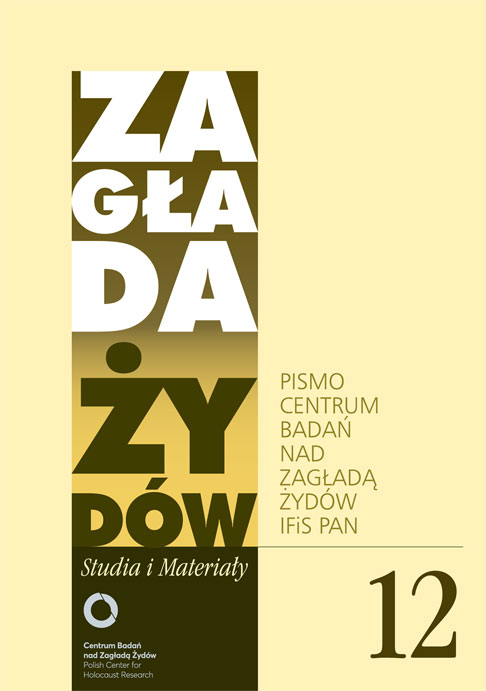Frankenstein w warszawskim getcie. Historia i legenda
Zagłada Żydów. Studia i Materiały, Nr 12 (2016), Strony: 187-208
Data zgłoszenia: 2020-10-19Data publikacji: 2016-11-30
 https://doi.org/10.32927/ZZSiM.414
https://doi.org/10.32927/ZZSiM.414
Abstrakt
The article deals with one exceptionally violent German perpetrator who was part of the occupation force in Warsaw during the Second World War. Inside the Ghetto he maltreated and killed a large number of women, children and men for his own personal pleasure. He did this to such an extensive degree that the population perceived him as monstrous being that was given the nickname „Frankenstein”. The article is mainly based on statements in juridical investigations, from the victim as well as from the perpetrator perspective, supplemented with some selected additional sources. Firstly the source corpus will be evaluated, to work out how these historical sources can be used to shed light on „Frankenstein”. This will be followed by an analysis of the actual identity of this perpetrator. It will be shown that he was, contrary to common belief, not necessarily the SS-Rottenführer Josef Blösche but more likely a member of the German Police Battalion 61. In the end the question will be also raised of how it was possible – despite all rules and regulations – that ghetto guards like him behaved like a marauding soldiery.
Słowa kluczowe
getto warszawskie , Zagłada , policja umundurowana , zbrodnie okupacyjne , warty w getcie , batalion policyjny , sprawca , przemoc , strach , terror , życie w getcie
Licencja
Prawa autorskie (c) 2016 Autor&"Zagłada Żydów. Studia i Materiały"

Utwór dostępny jest na licencji Creative Commons Uznanie autorstwa 4.0 Międzynarodowe.
https://creativecommons.org/licenses/by/4.0
Czasopismo publikowane jest w standardzie Diamond Open Access na licencji CC-BY-4.0 Deed - Uznanie autorstwa 4.0 Międzynarodowa - Creative Commons
Podobne artykuły
- Jacek Leociak, On the Abuses in Research of the Holocaust Experience , Zagłada Żydów. Studia i Materiały: 2010: Holocaust Studies and Materials
- Jan Grabowski, Lea Balint, The Diary of Hinda and Chanina Malachi , Zagłada Żydów. Studia i Materiały: 2008: Holocaust Studies and Materials
- Marian Turski, Wspomnienie o likwidacji getta łódzkiego , Zagłada Żydów. Studia i Materiały: Nr 16 (2020)
- Jan Tomasz Gross, Czy Zagłada jest ich historią, czy naszą? (Plaidoyer w przedmiocie ustanowienia w Polsce miejsca pamięci poświęconego Zagładzie) , Zagłada Żydów. Studia i Materiały: Nr 13 (2017)
- Piotr Kendziorek, Martyna Jonas-Kowalik, Jutro wolni? Komuniści w ruchu oporu w getcie warszawskim , Zagłada Żydów. Studia i Materiały: Nr 19 (2023)
- Piotr Litka, Zdzisław Lorek, Grzegorz Pawlikowski, Śledztwo sędziego Władysława Bednarza w sprawie niemieckiego obozu zagłady Kulmhof , Zagłada Żydów. Studia i Materiały: Nr 14 (2018)
- Witold Mędykowski, The Jews are Coming Back: The Return of the Jews to their countries of origin after WW II, edited by David Bankier , Zagłada Żydów. Studia i Materiały: Nr 1 (2005)
- Bartomiej Grzanka, Działalność SS-Sonderkommando Kulmhof w lutym i marcu 1942 r. w świetle dowodów księgowych Sonderkonto 12300 z zasobu Archiwum Państwowego w Łodzi , Zagłada Żydów. Studia i Materiały: Nr 16 (2020)
- Klara Jackl, Czy to ja ... Pamiętnik obrazkowy Henryka Becka z czasu wojny i Zagłady , Zagłada Żydów. Studia i Materiały: Nr 20 (2024)
- Maria Ferenc-Piotrowska, „Czarna, ogromna chmura wisi nad nami i na pewno spadnie…” Żydzi w miastach i miasteczkach Generalnego Gubernatorstwa wobec wiadomości o akcji „Reinhardt” , Zagłada Żydów. Studia i Materiały: Nr 13 (2017)
<< < 1 2 3 4 5 6 7 8 9 10 11 12 13 14 15 16 17 18 19 20 21 22 23 24 25 26 27 28 29 30 31 32 33 34 35 36 37 38 39 40 41 42 43 44 45 46 47 48 49 50 > >>
Możesz również Rozpocznij zaawansowane wyszukiwanie podobieństw dla tego artykułu.
 English
English
 Język Polski
Język Polski




